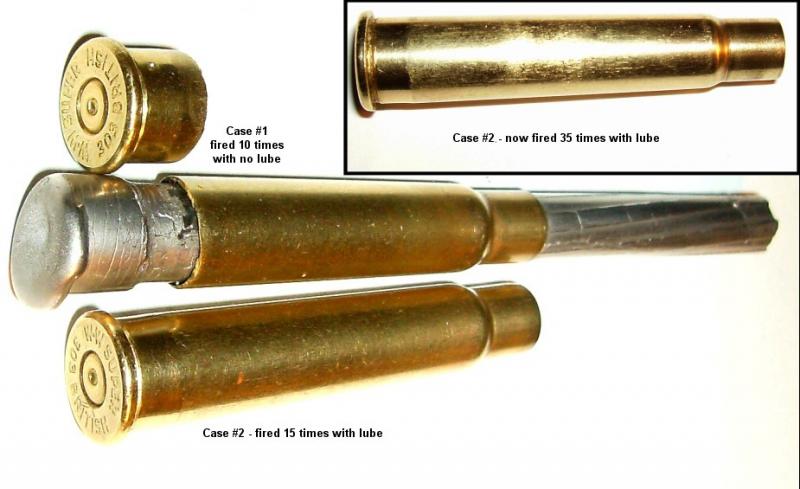I'm not sure it's accurate to assert that all US-made .303 cases are likely to come apart prematurely when fired with full-power loads. Recently I made a test to see if I could reproduce Ed's results with Winchester cases and maybe shed some light on the failure mechanism.
I first selected two W-W .303 cases that weren't brand new, but showed no signs of stretching or thinning. (I normally shoot my .303's with fairly mild cast-bullet loads that don't produce enough pressure to stretch cases.) Then I reloaded and fired one of them until it separated, made one small change in firing preparation and loaded/fired the other one until I got tired of the experiment.
Upper case was collet-die neck-sized, reloaded, and fired 10 times in excellent-condition LithgowSMLE with 180-grain bullet over 41 grains of RL-15 (1 grain under "maximum" per Alliant website data - MV 2450 fps). Case elongated from 2.210" to 2.222" in five shots, was trimmed back to 2.210" and separated on 10th shot. (Case body was stuck so firmly in chamber that chamber cast was needed to remove it - and it still didn't budge until the cast has been driven about 1/4".)
Lower case, from same batch, has been reloaded and fired 15 times with same load in same rifle. Its length has remained at 2.210" - with zero elongation and no internal or external signs of stretch.
The difference? Upper case was kept clean and dry throughout test - lower case received a very thin application of castor oil before each firing. Because the forward portion of this case was prevented from adhering to the chamber walls, the stretching and thinning I observed with the first (dry) case didn't occur at all.
One possible conclusion from this exercise is that the combined bolt compression and receiver elongation inherent in the rear-locking SMLE action (not "weak" but simply a bit more flexible than front-locking designs of similar mass) was enough to allow the case head to back out approximately .002" with each shot at this pressure (cumulative .012" elongation for 5 shots, dry). Since chambering didn't become increasingly difficult during the test, I conclude that, once pressure dropped, the elastic bolt and receiver returned to their unstressed dimensions with enough force to push the case back into the chamber, restoring the head/shoulder dimension by moving the relatively weak shoulder, while the stronger area immediately ahead of the solid web remained in the stretched/thinned condition it acquired at peak pressure. Consequently, each shot effectively lengthened the neck - at the expense of thickness near the head. With the lubed case, no stretching occured since action flex just moved the shoulder back and forth.
While it's well-established that lubricated cases allow more force to be transmitted to the bolt face than do dry cases, studies quantifying the difference are rarely cited. According to one impressive-appearing modeling exercise (at Rifle Chamber Finish & Friction Effects on Bolt Load and Case Head Thinning Calculations done with LS-DYNA ) the calculated difference in peak bolt face load between a greased case and a dry case in a smooth chamber is about 10%. If this model is accurate, the difference is barely significant and is in fact less than the normal acceptable variation in peak pressure within a fairly small sample of identical loads.
Whether or not any increased wear on the rifle action resulting from the added load caused by lubricated cases is more important than cartridge case longevity is an individual judgment call. I believe that with sufficient care (and moderate powder charges), lubed cases can provide a practical alternative to premature separations that may be useful for experienced handloaders who understand the risks and benefits. Many respected sources disagree.
- Knowledge Library

- MKL Entry of the Month
- Australia
- Austro-Hungarian Empire
- Canada
- Czechoslovakia
- Denmark
- Finland
- France/Belgium
- Germany
- Italy
- Japan
- Norway
- Russia
- South America
- Sweden
- Switzerland
- Turkey
- United Kingdom
- United States
- Yugoslavia
- Is my rifle authentic or a fake?
- Jay Currah's Lee Enfield Web Site
- On-line Service Records (Canada)
- Technical Articles/Research
- Forum
- Classifieds

- What's New?
-
Photo Gallery

- Photo Gallery Options
- Photo Gallery Home
- Search Photo Gallery List
-
Photo Gallery Search
- Video Club

- iTrader












 PM
PM

